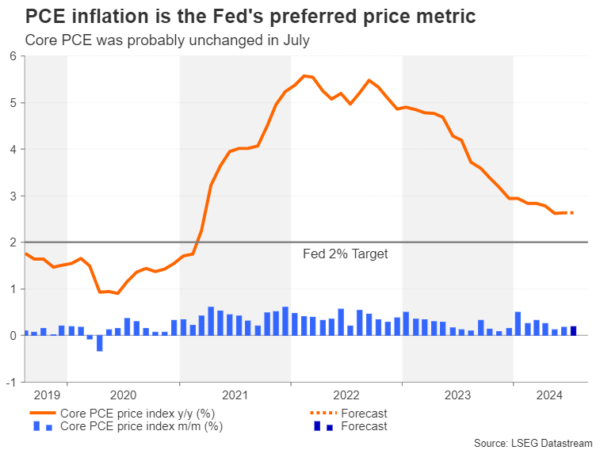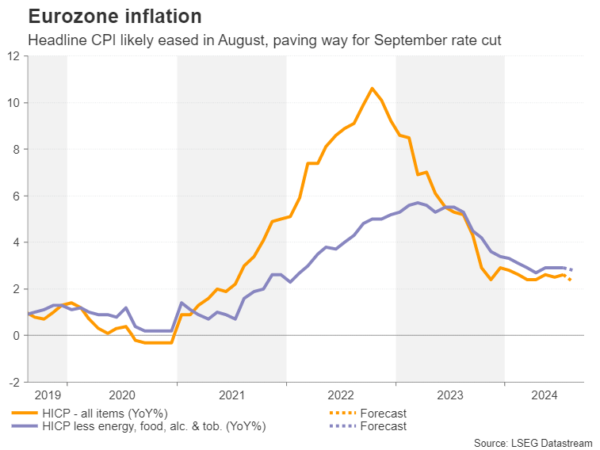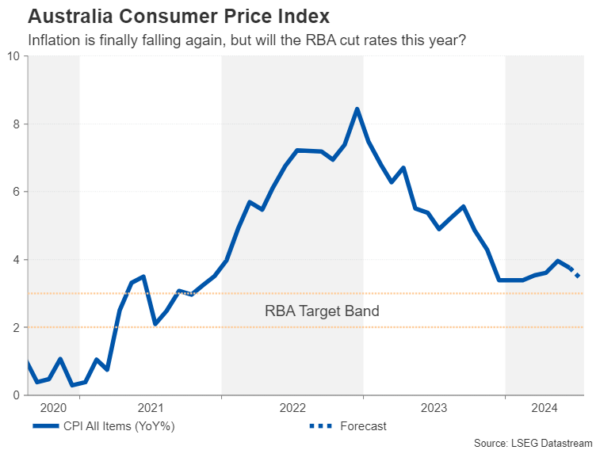- Focus to stay on the Fed as PCE inflation to be week’s main highlight
- Eurozone inflation data to be crucial for ECB rate cut hopes
- Australian and Tokyo CPI, plus Canadian GDP also on the agenda
Will PCE inflation disappoint dovish expectations?
The Fed’s long-anticipated dovish pivot is upon us and markets are bracing for the first US rate cut of this cycle at the September 17-18 meeting. However, the Fed remains largely data dependent and with the September decision also containing the updated dot plot, the rate path is far from being set in stone.
Hawkish members of the FOMC still see some upside risks to inflation and if the Fed is to cut rates by as much as the 100 basis points that’s priced in by the markets for 2024, the incoming data will need to surprise significantly to the downside.
Hence, Friday’s Personal Income and Outlays report, which contains consumption numbers as well as the all-important personal consumption expenditures (PCE) price index, will take centre stage once again.
The core PCE price index was unchanged at 2.6% y/y in June and it likely stayed there in July. The headline PCE figure is also forecast to have held steady at 2.5% y/y.
Personal consumption, meanwhile, is expected to have climbed a healthy 0.5% month-on-month in July and whilst that might further allay recession jitters, it could dent hopes of rates being slashed aggressively. A projected rise in personal income of just 0.2% m/m could go some way, however, in offsetting concerns that American consumers are about to splurge again.
The dollar is on course for its fifth weekly loss against a basket of currencies, making it vulnerable to a rebound in the event of a hotter-than-anticipated report.
Treasury auctions, Nvidia earnings on tap too
Ahead of the PCE readings, July durable goods orders will kick things off on Monday and will be followed by the consumer confidence gauge for August on Tuesday. Additionally, the second estimate of Q2 GDP growth is out on Thursday and the Chicago PMI is due on Friday.
There will be limited Fedspeak, with investors having to go with the tone set by Chair Powell in his Jackson Hole address until next Friday’s data, although a large number of Treasury auctions over the coming week could spur some volatility in bond markets as trading volumes pick up from the summer lull.
But in equity markets, traders will also be guided by Nvidia’s latest earnings due on Wednesday.
Last Eurozone CPI report before next ECB meeting
The euro has surged this month against the US dollar, trading above the $1.11 level for the first time since December. The gains come despite intense expectations that the European Central Bank will lower interest rates again in September.
However, whilst there’s a strong likelihood of a September move, there’s a small but significant risk that ECB policymakers will not be convinced by then that another cut is needed. Friday’s flash CPI estimate for August will be vital in giving the green light for more easing in September.
The Eurozone’s headline inflation rate is forecast to moderate from 2.6% y/y in July to 2.3% in August, bringing it much closer to the ECB’s 2% goal. The core rate that excludes all volatile items is expected to tick down slightly to 2.8% y/y.
Any disappointment in the inflation readings could boost the euro further versus the greenback, although it’s unlikely to change the market consensus for a September cut.
In other releases out of the euro area, Germany’s Ifo business climate survey will be watched on Monday, and the Eurozone economic sentiment indicator will follow on Thursday.
Tokyo CPI to be key as BoJ ponders next move
The yen, or more specifically, the Bank of Japan, is partly responsible for the dollar’s woes. The reality that years of ultra-loose monetary policy is coming to an end in Japan finally struck a nerve with investors when the Bank of Japan simultaneously hiked rates and announced the gradual halving of its asset purchases at its July meeting.
There’s a sizeable probability that the BoJ will raise rates for a third time by year end. Governor Ueda has hinted that more rate increases are on the cards if the economy and inflation remain on track even though the Bank is concerned about the current instability in the markets. Thus, the Tokyo CPI data out on Friday will be important as they are seen as a precursor to the nationwide figures, which are published much later.
There will be a slew of other indicators on Friday, including preliminary industrial production for July, retail sales, and the jobless rate.
RBA hoping for more progress on inflation
In Australia, inflation will also be the dominant theme. The monthly prints are due on Wednesday and will be watched closely amid worries about inflation remaining sticky. In June, the annual CPI rate finally edged down to 3.8%, having risen in the months prior. But policymakers at the Reserve Bank of Australia will want to see further declines before dropping their hawkish bias.
If there was no fresh progress in July, the RBA is almost certain to continue ruling out a rate this year and this would be positive for the Australian dollar, which has rallied by almost 3% against its US counterpart in August. But there could be some downside risks from Q2 data on construction (Wednesday) and capital expenditure (Thursday) if they miss expectations.
Will Canadian GDP matter for BoC rate cut bets?
A central bank that is well ahead in the rate cutting race is the Bank of Canada. Investors have priced in a more than 90% chance of another 25-bps reduction in September as Canadian inflation has generally been moving in line with projections.
However, stronger-than-expected economic growth would be one reason why policymakers might decide to skip a meeting, putting the spotlight on Friday’s Q2 GDP numbers. A day earlier, wage growth figures for June might also attract some attention for the Canadian dollar.


















